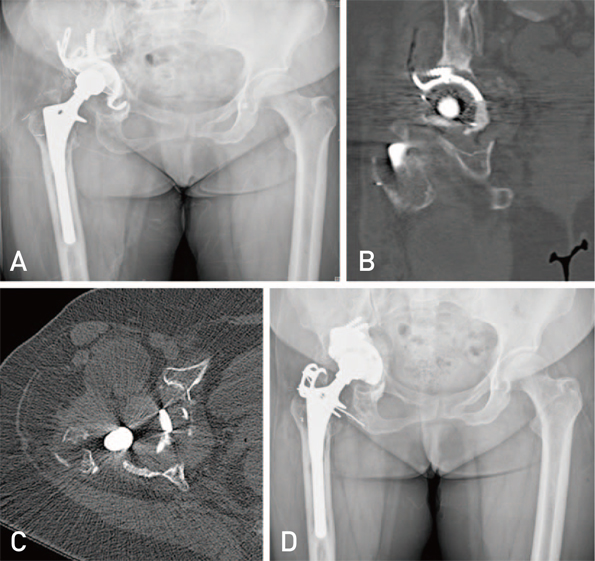Hip Pelvis.
2016 Jun;28(2):98-103. 10.5371/hp.2016.28.2.98.
Revision Total Hip Arthroplasty Using Tantalum Augment in Patients with Paprosky III or IV Acetabular Bone Defects: A Minimum 2-year Follow Up Study
- Affiliations
-
- 1Department of Orthopedic Surgery, Samsung Changwon Hospital, Sungkyunkwan University School of Medicine, Changwon, Korea.
- 2Department of Orthopedic Surgery, Samsung Medical Center, Sungkyunkwan University School of Medicine, Seoul, Korea. ysp3504@skku.edu
- KMID: 2328345
- DOI: http://doi.org/10.5371/hp.2016.28.2.98
Abstract
- PURPOSE
The purpose of this study is to report the short-term outcomes of revision total hip arthroplasty (THA) using tantalum augments in patients with severe acetabular bone defects.
MATERIALS AND METHODS
We retrospectively analyzed 15 revision THAs performed in 15 patients using tantalum augments between June 2010 and December 2013. Acetabular bone defects were Paprosky type IIIA in 7 hips, type IIIB in 7, and type IV in 1. The causes of revision surgery were aseptic loosening in 12 hips and deep infection in 3. Revisions were first in 1 hip, second in 3, and third in 11. Six patients were male and 9 female with a mean age of 59 years (range, 48-75 years). Mean follow-up was 29 months (range, 24-48 months).
RESULTS
Mean Harris hip score was improved from 34 points (range, 12-54 points) preoperatively to 84 points (range, 38-90 points) at final follow-up. On the final follow-up radiographs, there were 12 hips (80.0%) with stable fixation of the acetabular cup, 2 (13.3%) with secondary stability after mild acetabular protrusion, and 1 (6.7%) with radiolucency around the acetabular cup without mechanical symptoms. Complications included one patient with acute hematogenous infection managed by surgical debridement and long-term antibiotic therapy. There were no cases with nerve palsy or dislocation during the follow-up period.
CONCLUSION
The present study showed satisfactory clinical and radiographic outcomes of revision THA using tantalum augments due to severe acetabular bone defects of Paprosky type III or IV at a minimum follow-up of 2 years.
MeSH Terms
Figure
Reference
-
1. Bozic KJ, Kurtz SM, Lau E, Ong K, Vail TP, Berry DJ. The epidemiology of revision total hip arthroplasty in the United States. J Bone Joint Surg Am. 2009; 91:128–133.
Article2. Paprosky WG, Perona PG, Lawrence JM. Acetabular defect classification and surgical reconstruction in revision arthroplasty. A 6-year follow-up evaluation. J Arthroplasty. 1994; 9:33–44.
Article3. Long WJ, Noiseux NO, Mabry TM, Hanssen AD, Lewallen DG. Uncemented porous tantalum acetabular components: Early follow-up and failures in 599 revision total hip arthroplasties. Iowa Orthop J. 2015; 35:108–113.4. Elganzoury I, Bassiony AA. Early results of trabecular metal augment for acetabular reconstruction in revision hip arthroplasty. Acta Orthop Belg. 2013; 79:530–535.5. Gehrke T, Bangert Y, Schwantes B, Gebauer M, Kendoff D. Acetabular revision in THA using tantalum augments combined with impaction bone grafting. Hip Int. 2013; 23:359–365.
Article6. Harris WH. Traumatic arthritis of the hip after dislocation and acetabular fractures: treatment by mold arthroplasty. An end-result study using a new method of result evaluation. J Bone Joint Surg Am. 1969; 51:737–755.
Article7. DeLee JG, Charnley J. Radiological demarcation of cemented sockets in total hip replacement. Clin Orthop Relat Res. 1976; (121):20–32.
Article8. Lim SJ, Lee KH, Park SH, Park YS. Medium-term results of cementation of a highly cross-linked polyethylene liner into a well-fixed acetabular shell in revision hip arthroplasty. J Arthroplasty. 2014; 29:634–637.
Article9. Shi HF, Xiong J, Chen YX, Wang JF, Wang YH. Radiographic analysis of the restoration of hip joint center following open reduction and internal fixation of acetabular fractures: a retrospective cohort study. BMC Musculoskelet Disord. 2014; 15:277.
Article10. Kurtz S, Ong K, Lau E, Mowat F, Halpern M. Projections of primary and revision hip and knee arthroplasty in the United States from 2005 to 2030. J Bone Joint Surg Am. 2007; 89:780–785.
Article11. Haynes JA, Stambough JB, Sassoon AA, Johnson SR, Clohisy JC, Nunley RM. Contemporary surgical indications and referral trends in revision total hip arthroplasty: A 10-year review. J Arthroplasty. 2016; 31:622–625.
Article12. Grappiolo G, Loppini M, Longo UG, Traverso F, Mazziotta G, Denaro V. Trabecular metal augments for the management of Paprosky type III defects without pelvic discontinuity. J Arthroplasty. 2015; 30:1024–1029.
Article13. Tokarski AT, Novack TA, Parvizi J. Is tantalum protective against infection in revision total hip arthroplasty? Bone Joint J. 2015; 97-B:45–49.
Article14. Del Gaizo DJ, Kancherla V, Sporer SM, Paprosky WG. Tantalum augments for paprosky IIIA defects remain stable at midterm followup. Clin Orthop Relat Res. 2012; 470:395–401.
Article
- Full Text Links
- Actions
-
Cited
- CITED
-
- Close
- Share
- Similar articles
-
- Revision Total Hip Arthroplasty: Acetabular Cup
- Acetabular Cup Revision
- Acetabular Revision Total Hip Arthroplasty Using Uncemented Cup and Morselized Impacted Allograft
- Revision Total Hip Arthroplasty of an Acetabular Cup with Acetabular Bone Defects
- Revision Total Hip Arthroplasty using Allogenic Impaction Bone Grafts and Cemented Cup in Acetabular Bone Deficiency: Minimum Seven Years Clinical and Radiological Analysis


